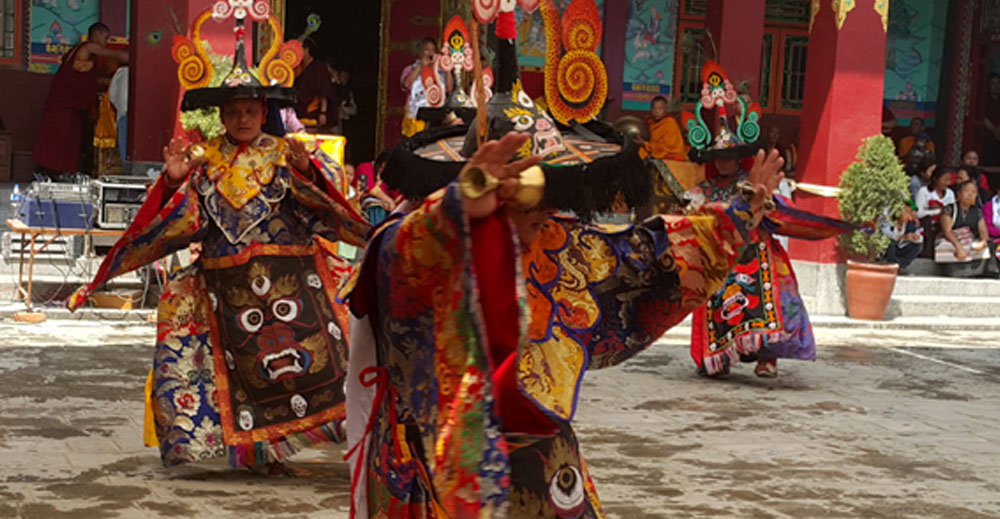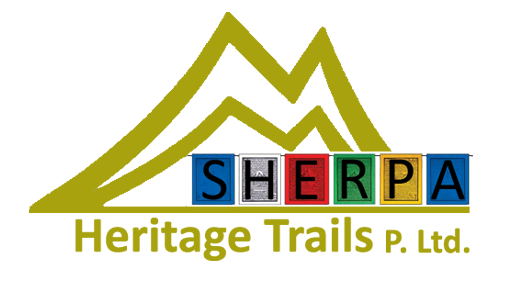Mani Rimdu festival and Lower Everest trek 10 Days
-
Duration: 10 days
-
Trip level: easy (info?)
-
Maximum altitude: 4065 m
-
Accommodation: teahouse/lodge
-
Season: October 26th – 5th November 2020

Mani Rimdu festival combined with the Lower Everest trek is a perfect combination to enjoy trekking the Himalaya with the celebration of an authentic sacred festival. For five days you will hike through a remote and unspoiled part of the lower Everest region. The trail takes you through beautiful rhododendron forests and yak pastures. The traditional Buddhist culture is found along the trail. You pass by ancient mani walls (prayer walls), chortens and fluttering prayer flags. The view from the Pikey Peak is memorable. On a clear day you can a greater part of the Nepal Himalaya. Before arriving the monastery of Chiwong, you have seen other monasteries as well. At the secluded monastery you join the religious Mani Rimdu festival which is being held at the monasteries of Thyangboche and Chiwong. The festival is vibrant with traditional rituals like mask dances, a fire puja celebration and a sand mantra. Every year the date varies as it is depending on the Buddhist lunar calendar.Mani Rimdu takes place between mid-October and mid-November.
From the beginning until the end of the festival, 24 hours Puja (rituals) will be performed by the monks to consecrate the Mandala, the Mani Rilwu (sacred pills), the Tshereel (pills for long life) and the Torma.
The Sand Mandala
The sand mandala is carefully constructed, grain by grain, from colored sand. It is an intricate and symbolic design that takes many days to complete. Protective dagger deities are placed around the mandala, and the bowl of Mani Rilwu pills (spiritual medicine) is placed above the center.
The Rilwu Pills
Rinpoche calls this “liberation by eating”. The Rilwu are distributed to everyone, after he gives a long life empowerment to the people who come.
The Torma
The torma is made from barley flour and decorated with colored butter. It begins by symbolizing the body of the deity, and by the end of the ceremony, symbolizes enlightenment itself. It stands in the front of the mandala on its own shrine, at the very heart of the temple
Day 01 October 26th 2020. Drive Kathmandu to Pattale (2625 m – 7 hrs.)
Day 02 October 27th 2020. Trek to Japre (2820 m – 6 hrs.)
Day 03 October 28th 2020. Trek to High camp (3615 m – 6 hrs.)
Day 04 October 29th 2020. Climb to Pikey Peak summit (4065 m) and trek to Bhanyang (2875 m – 6 hrs.)
Day 05 October 30th 2020. Trek to Chiwong Khop (2590m – 7 hrs.)
Day 06 October 31st 2020. Trek to Chiwong Monastery (2715m – 2 hrs.); start of Mani Rimdu; overnight at Chiwong Khop.
The Empowerment (Wong)
The Wong is the opening day of public ceremony. It’s performed on the full moon day, of the tenth month in the Tibetan lunar calendar. The sacred Mani Rilwu (sacred pills) and Tshereel (pills for long life), are given to everyone attending.
Day 07 November 1st 2019. Trek to Chiwong Monastery (2 hrs.); second day of Mani Rimdu; overnight at Chiwong Khop.
The Dances (Chham)
The dances take place on the 2nd public day of Mani Rimdu.
Symbolic demons are conquered, chase away, or transformed to Protectors of Dharma. As the theme of the dance positive forces fight with those of disorder through the dances. The dances convey Buddhist teaching on many levels from the simplest to the most philosophical. During the dance the monks are believed to become divine being. The dances are only performed during Mani Rimdu because they are considered to be very sacred, and not for ordinary entertainment.
Day 08 Novemer 2nd 2019. Trek to Chiwong Monastery (2 hrs.); third day of Mani Rimdu; overnight at Chiwong Khop.
The Fire Puja (Jinsak)
The Fire Puja is performed in the yard. The Fire Puja is an offering to Agni (the god of fire), and to the Gods of the mandala – to allay all harm in the world. The harm is visualized as dissolving into the grain and butter is burned.
Day 09 November 3rd 2020. Trek to Chiwong Monastery (2 hrs.);fourth day of Mani Rimdu; overnight at Paphlu (4 hrs. trek).
The Naga Mandala ( The Naga)
The Naga is a mythical serpentine creature appearing as human or snake, or both together with a human torso above and a coiled snakes tail below. They inhabit the regions beneath the earth and the oceans. The Naga sand mandala in the temple is ritually pulled to pieces, and the sand is given as an offering to the serpent gods.
Day 10 November 5th 2020. Drive Phaplu to Kathmandu (8 hrs.)
During the trekking season prices may rise. The final price depends on the trekking season, group size and, if applicable, the cost of the local transfers.
Please inquire about the price.
We have noticed the ways of travelling and booking are changing rapidly. Many customers book a hotel or a guesthouse themselves prior to their journey. However, we would happily like to arrange accommodation for you. We have excellent contacts with various hotels and guesthouses and will be able to offer a good price rate for any budget.
When you arrive at the International Airport we will pick you up and bring you to your accommodation. Here we will give you a short briefing about the trek. In addition we will give you advice about hygienic food, customs, and sightseeing in Kathmandu.
Cost include:
-Pick up and drop off from Kathmandu International Airport to hotel
-Private drive Kathmandu to Pattale; private drive Paphlu to Kathmandu
-Certificate of CO2- emission free all transport in Nepal
-Licensed and certified mountain guide. Well experienced and English speaking
-Salary, food, accommodation and insurance for the mountain guide
-Teahouse room during tour
-Three meals a day: breakfast/lunch/ dinner (local food during Mani Rimdu). Tea/ hot water
-TIMS card and local taxes
-Support of the Sherpa Heritage Trails head office in Kathmandu
Cost exclude:
-International flight to Kathmandu
-Nepal entrance visa
-Accommodation and all meals in Kathmandu
-Porter service for carrying luggage. One porter for two persons, max. luggage 10 kg. per person
-All other beverage bills, hot shower, internet services, laundry and battery charge during tour
-Personal travel insurance
-Rescue operation charge in case of an emergency
-Any cost that arises due to a change of itinerary like flight delay, natural calamities, etc.
-Gratitude and tips for mountain guide
